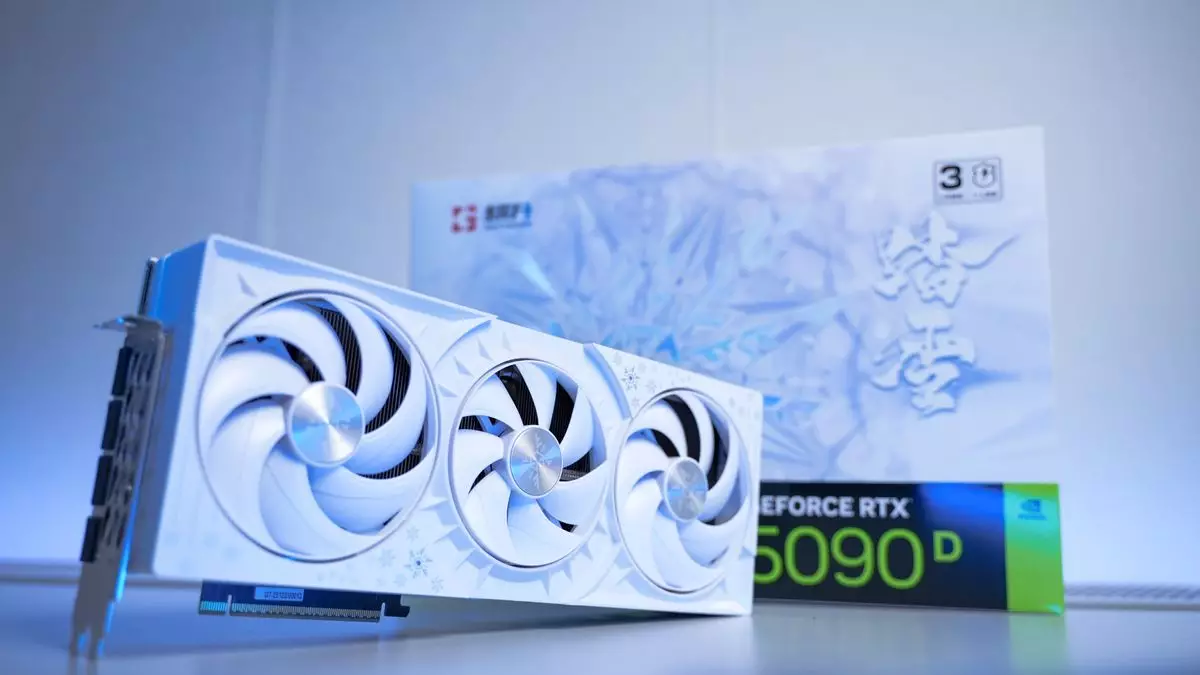As the tech world prepares for the impending launch of Nvidia’s RTX 50 series graphics cards, one standout model has caught everyone’s eye: the Gainward RTX 5090 D. With its stunning frosty white design embellished with captivating snowflakes and sharp thorns encircling the fan, this graphics card presents a compelling invitation for enthusiasts and casual gamers alike. Beyond the aesthetic appeal, however, lies a complex narrative shaped by international trade policies and the strategic adjustments of tech companies to navigate these turbulent waters.
At first glance, the Gainward RTX 5090 D captivates with its design. The all-white exterior stands in stark contrast to the more conventional black offerings that saturate the market. The snowflake motifs lend an air of uniqueness, making it not just a piece of hardware but a striking addition to any gaming setup. It’s a rarity to see a graphics card that prioritizes artistic design as much as raw performance, and while some may critique the prevalence of branding on the device, it’s easy to see how Gainward boasts its identity when they have created something so visually pleasing. They rightfully take pride in their creation, which blends functionality with flair.
Despite its attractive visuals, the Gainward RTX 5090 D represents a compromise in performance due to external factors influencing its production. This model, like the earlier RTX 4090 D, was formulated in response to U.S. export restriction laws affecting technology earmarked for China. As a result, the RTX 5090 D has been deliberately constrained in its total processing performance (TPP) and performance density (TD), which ultimately places it a step below its full-power counterpart, the standard RTX 5090. The RAM configuration remains impressive at 32 GB of GDDR7 and 21,760 CUDA cores—equivalent to the standard version—but the uncertainties surrounding real-world performance metrics leave potential buyers in a conundrum.
The current landscape of international tech trade has introduced significant complexities. Nvidia’s hurdles in exporting technology are part of a broader narrative that includes issues like the antitrust investigation by the Chinese government into Nvidia’s acquisition of Mellanox Technologies. While the initial acquisition found acceptance with caveats, ongoing sanctions complicate the relationship between technological innovation and regulatory restrictions. The RTX 5090 D serves as a symbol of this struggle, representing not only a creative response to market demands but also a reflection of the geopolitical intricacies affecting the tech industry.
The allure of exclusive technology isn’t lost on consumers. Many have lamented the failure to access intriguing collaborations like Razer’s Pokémon-themed gear and Evangelion-branded hardware that remain limited to the Chinese marketplace. The design of the RTX 5090 D falls in line with this exclusivity trend, igniting desire in the international community who view it as more than just a graphics card—it’s a limited collector’s item that melds utility with artistry. Although the performance may be lackluster relative to non-D models, the aesthetic allure alone may tempt many into craving possession.
Operating at the intersection of design and performance, the Gainward RTX 5090 D exemplifies the innovative approaches manufacturers are adopting amidst challenging conditions. While it may not deliver the pinnacle of power Nvidia is known for, its captivating appearance and potential as a collector’s item create a unique appeal. For many enthusiastic gamers and tech aficionados, the question remains: What is the value of beauty in technology? As we await further details on performance and availability, one thing is clear—the RTX 5090 D does not simply promise to be a functional component; it seeks to enchant and engage, bringing art into the realm of high-caliber computing.


Leave a Reply